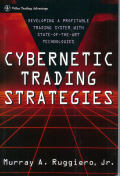.jpg)
Follow
Us:    
|
Rob Booker's Indicator
is Available Now!
My friend Rob Booker built a cool indicator for your charts for spotting trends. He has been around for a long time and has a no-nonsense approach to his personal trading.
Rob transferred his approach to trading directly to this indicator - and it's here for you to have right now!
Rob is offering his indicator for your charts at NO CHARGE - but not for long...
Don't Miss It...
Click Here Now
His indicator is best known for helping you:
- See trends FASTER than before
- Take silly guesswork out of your trades
- Find super-high probability profit targets and conquer greed forever
- Clear stop-out rules, so you close the worst trades fast
- Rocket-boost your risk/reward ratio
Grab It Now: CLICK HERE

|
|
Murray Ruggiero develops marketing timing systems using advanced technologies. Previously, he was a vice president with Promised Land Technologies, Inc., and the inventor of a patented method for embedding a neural network into a spreadsheet. He has been researching advanced technologies since 1988 and was featured in BusinessWeek as one of the leading experts using neural networks in finance and investing. Mr. Ruggiero has been contributing editor of Futures Magazine since June 1994 and has a monthly column, “Trading and Technology.”
 |
Simulated Test Trading Results
Are Astonishing --

Amazing Book Reveals Powerful "Insider" Methods Worth Over $2.2 Million!
Renowned Analyst Murray Ruggiero Stuns Investment World By Releasing Details On Dozens Of Tested Methods Anyone Can Use To Strive For 5- And 6-Figure Trading Profits Every Year:
• Intermarket divergence method makes $513,325 in S&P futures!
• Seasonal corn futures strategy yields 200% annual profits!
• Correlation method makes $88,200 in T-Bonds!
• Plus dozens more!
BOOST YOUR PROFITS!
Forget the scary title; this book is about how you can use the newest, latest technical analysis and money management techniques designed to rocket your profits to new, all-time highs.
Using Technical Analysis
to Increase Your Profits
Cybernetic Trading Strategies
|
|

Better
Business Bureau
 |
|
Click on authors name
to learn more
|
| |
|
|
Inside Trading features Murray Ruggiero this week, who explains how data transforms are used when developing a trading system.
Next, Lee Gettess shares his weekly video on what he expects from the bond and S&P markets.
Then, Don Fishback gives examples of Straddle and Strangle option strategies.
Last, Chuck Hughes brings us his Guaranteed Real Optioneering Winners - Optioneering Newsletter.
Enjoy!
Adrienne LaVigne
TradeWins Publishing
 |
|
Trading System Development: Data Transforms
by
Murray Ruggiero
The following
is an excerpt from Murray Ruggiero's Cybernetic Trading Strategies
There is an almost infinite number of different types of transforms you can use to preprocess data. Let’s discuss some of the general types of transforms in detail.
Standard Technical Indicators
Standard technical indicators and proprietary indicators used by market analysts are great sources for data transforms for preprocessing. The most popular indicators to use in a neural network are MACD, stochastics, and ADX. Usually, these three are used together because stochastics work in trading range markets and MACD works in trending markets. ADX is used to identify when the market is trending versus not trending.
Another use of technical indicators as data transforms is to further transform the output of one or more indicators to extract what an indicator is trying to reveal about the market. When using technical indicators in a neural network, I have found that the intermediate calculations used to make the indicators are often powerful inputs for a model. As an example, let’s look at RSI, which is calculated as follows: RSI = 100 (100/(1 + RS)), where RS = average of net up closes for a selected number of days/average of net down closes for a selected number of days. We can use each of these averages as input to a neural network.
Data Normalization
Data normalization is a very important data transform in developing preprocessing for almost every modeling method. Let’s now examine two classic methods of normalization:
1. Normalize the data from 0 to 1 and use the formula as follows:
X = Value – Lowest (Value, N)/(Highest (Value, n) – Lowest (Value, n)).
If you want to scale between -1 and 1, subtract 0.5 and then multiply by 2.
2. Normalize relative to the mean and standard deviation. An example of this calculation is shown below.
Percent or Raw Differences
One of the most common transforms used in developing any predictive model is the difference or momentum type of transform. There are several widely used transforms of this type as shown below.
Data Transforms
|
Lee
Gettess' Market Sense
by Lee Gettess
Lee
Gettess is a top trader who is excited
to bring you his video newsletter.
Each week, Lee will share his predictions
on what he anticipates from the bond
and S&P markets.
Watch
Video
|
Straddles and Strangles
by Don Fishback
The following
is an excerpt from Don Fishback's ODDS Options Wizardry from A to Z
A straddle is the purchase or sale of a put and a call of the same month, same underlying market and same strike price. A strangle has the same characteristics with one exception: Different strike prices for the put and call.
Straddle Example
Assume your analysis indicates that volatility for Dow Jones Index options is very low and you expect volatility to increase sharply. You are not sure if prices will move higher or lower, but want to take advantage of the coming increase in volatility. You decide to buy December 86 straddle but do not want to pay more than 11 per spread for the position. The 86 calls traded last at 4; the 86 puts at 7 ½.
To enter an option Straddle Order you would need to provide the information shown in the table below.
Enter the order as follows:
ACCOUNT 12345
BUY 3 DEC 86 DJX CALLS to OPEN
BUY 3 DEC 86 DJX PUTS to OPEN
11 DEBIT
As with any multiple-position limit order you may only fill on one or two of the spreads but at a price no worse than 11 per spread. Maximum risk in this example is the amount of premium paid – while the profit potential is unlimited. When liquidating the position the order can go in as a spread or as individual options.
Straddles and Strangles
|
Guaranteed Real Optioneering Winners
by Chuck Hughes
The following is an excerpt from Chuck Hughes’ Optioneering Newsletter
Every week Chuck publishes his “Optioneering Newsletter”. The following are trade updates from his most recent issue.
Mini Dow Futures Monthly: Bullish trading in November could mark the beginning of the next leg of the long-term bull trend. If so, the uptrend could go much further and last a long time.
TQQQ Monthly: The first profit opportunity we will consider this week is in TQQQ. TQQQ is the ProShares UltraPro QQQ. TQQQ seeks to yield results that correspond to three times the daily performance of the QQQ.
TQQQ hit a new record high on October 10th. New record highs are bullish. A further advance is expected. Initial support on the monthly chart lies at last month’s low.
To Learn More Click Here
|
|